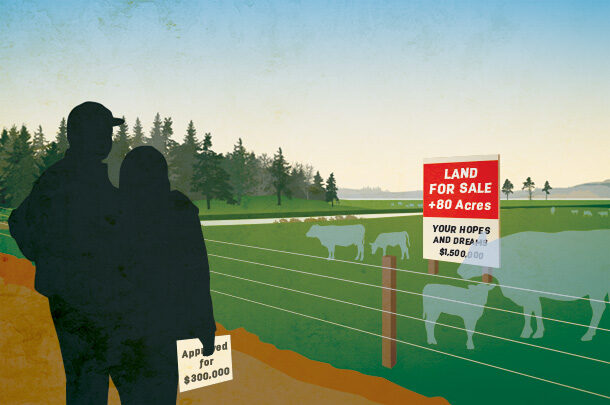Getting started in the cattle business is extremely capital-intensive, but alternatives such as custom grazing, running stocker cattle, leasing land or even cattle can be viable options.
You’ve probably heard “The only way to get into farming is to inherit it or marry it.” Years ago, I attended a farm financial seminar. The speaker told the students in the crowd to visit with at least one seasoned professional and ask for advice related to beginning a career in agriculture. Later, he asked the students to report what they learned. One replied, “I was told to remember I could make more money in 20 minutes by whom I chose to marry than I could earn in a lifetime.”
Unfortunately, that statement has some truth. Farming is extremely capital-intensive. For a cow-calf operation, consider what we invest in each mama cow. Across the country, land price and acres per cow will vary. Let’s say, though, it takes 3 acres per cow at a price of $3,000 per acre. The cow will cost you an additional $1,500. We’ve already invested more than $10,000 per cow before buying a pickup truck, stock trailers, squeeze chutes, tractor, ATV … you get the picture.
How can a beginning farmer come up with that kind of cash? He or she had better brush up on his or her courting skills to make that 20 minutes count.
Farm management 101: Three-legged stool
Many years ago, in farm management 101, I learned the farmer must access land, labor and capital. Each represents a leg in a three-legged stool. If you’re missing a leg, then the farm operation won’t work. However, a farmer doesn’t have to own or supply these inputs. He or she just needs “access” to them.
How can a beginning farmer get started without owning the land or having the capital to buy a cow herd? If that farmer can supply the labor, then he or she can lease or partner with someone to acquire the other two: land and capital.
Leasing
For years, beginning farmers and those looking to expand have leased land to grow their operation. Rather than invest $9,000 per cow buying land, a lease means you can use the land for a fraction of its value. In many parts of the country, as much as two-thirds of farmland is leased and operated by tenants.
Leasing cow herds has become more common, too. As cattle owners age, they may no longer be able to provide labor. However, they still have the land, a cow herd and capital. Rather than exit the business through a liquidation sale, aging producers may lease a herd to a beginning farmer through a cash or share arrangement and make a win-win situation for both parties.
Custom grazing
Some beginning farmers access capital through custom-grazing contracts. Rather than purchase a cow herd, they find ways to graze others’ cattle and get paid for it. Contracts can be obtained to graze cows, stockers or specialty animals such as replacement heifers or young bulls. Each livestock class has its advantages and disadvantages. The custom grazier chooses where to focus based on his or her strengths.
If you’re trying to choose the right model for you, one factor to consider is the length of your grazing season. If you grow a lot of grass in a short period, then short-season stockers provide flexibility to match livestock numbers with your forage growth curve. Calves arrive and leave the farm according to when forage is available.
You could also custom graze cows year-round. This model requires you to supply additional labor and management to calve them, vaccinate them, wean calves and so forth. Or you can simply take in dry cows for a short period and ship them back to the owner prior to calving. The appropriate model depends on a grazier’s available labor and management resources.
Low-investment model
For a moment, consider a young beginning farmer who has limited capital but good knowledge of forage production and how to manage cattle. Plus, he or she has an intense desire to farm. If the beginning farmer can lease pasture and establish a relationship with an existing farmer to custom graze stockers, then he or she can essentially start farming with practically no investment but sweat equity. The owner sends calves when grass is ready and picks them up when calves reach the desired weight or the forage supply is exhausted. The only requirements are some portable panels, a dart gun and possibly an ATV. The custom grazier gets paid for the gain and uses profits to expand the operation.
Making this work
What is the key to a good marriage? Wait, I thought we were talking about farming. You might be surprised about the similarities between marriage counseling and what we are discussing. Communication is the key to a good marriage and good landlord-tenant relationships.
When you access an asset owned by someone else, cultivating a relationship with the asset’s owner and communicating well will make the relationship more likely to last. This becomes even more important when talking about livestock. When you involve a living, breathing animal that can get sick or – worse yet – die, you really have to step up the communication. It requires constant communication with the livestock owner. Let that person know what you are doing and what challenges or issues arise. If the owner only hears from us when something bad happens, communication is not happening enough.
We also need to “overinvest” in stewardship of both the land and livestock we care for. For those of us who can’t afford to drop $1 million to acquire assets, how we invest our time is crucial. Investing a few extra hours to keep the land looking nice and additional TLC for livestock will pay dividends. Also, invest in your professional development such as attending seminars and reading books so you are constantly improving. Your most valuable asset is you, and those are investments you can never lose.
Remember, aging farmers may have invested 50 years in creating their cow herds. Unfortunately, they will never feel like anyone cares for their animals as well as they did. It takes a high level of trust between cattle owners and operators, and trust does not happen by accident.
Just like a good marriage, a good landlord-tenant relationship takes work to develop and maintain. Beginning farmers who put forth the effort to cultivate relationships can get started without someone having to die or by marrying right. As cattle producers continue to get older, more opportunities arise for beginning farmers who are willing to invest in those relationships.








